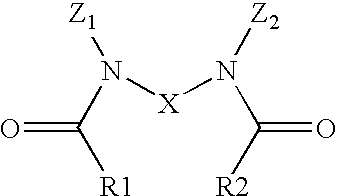Gemini glycidyl ether adducts of polyhydroxyalkyl alkylenediamines
a technology of glycidyl ether and polyhydroxyalkylenediamine, which is applied in the direction of detergent compounding agents, liquid displacement, separation processes, etc., can solve the problems of unsatisfactory efficiency of surfactant to reduce equilibrium surface tension, skin and eye irritation, and undesirable foaming, etc., to reduce dynamic and equilibrium surface tension, good solubility, and greater effectiveness
- Summary
- Abstract
- Description
- Claims
- Application Information
AI Technical Summary
Benefits of technology
Problems solved by technology
Method used
Image
Examples
examples 1-6
[0054]These examples illustrate the preparation of the glycidyl ether derivatives of N,N′-di(1-deoxyglucityl)alkylenediamines of the invention. The preparation of the 2-ethylhexyl adduct with N,N′-di(1-deoxyglucityl)ethylenediamine will be used for illustration. To a 3-necked 500 mL round-bottomed flask equipped with a stir bar, reflux condenser, addition funnel, and thermocouple was added N,N′-di(1-deoxyglucityl)ethylenediamine (3.65 g, 8.2 mmol, 1 eq.) which was prepared via a slightly modified version of the procedure described in WO 9519551 A1. To the diamine was added 50 g CH3CN and 20 g H2O and the mixture was stirred under nitrogen while heating to 60° C. with a heating mantle. To the reaction mixture was added 2-ethylhexyl glycidyl ether (Epodil® 746, 3.05 g, 16.4 mmol, 2 eq.) in a dropwise fashion over 15 minutes. Once all of the glycidyl ether was added, the reaction mixture was heated to 78° C. for a total of 9 hours. The reaction mixture was cooled to 60° C. and the solv...
examples 7-12
[0071]Equilibrium surface tensions were determined using a Kruss K-12 tensiometer with a platinum Wilhelmy plate, maintaining the temperature at 25±1° C. by means of a constant temperature circulating bath. Results reported are averages of 10 measurements over a 10-minute period having a standard deviation of less than 0.01 dyne / cm. In many instances the solutions took hours to reach equilibrium. This data was used to determine critical micelle concentrations, pC20 values, and limiting surface tensions and is listed in Table 2.
[0072]
TABLE 2Equilibrium Surfactant Data for Glycidyl EtherAdducts of Polyhydroxyalkyl AlkelenediaminesCritical MicelleConcentration(CMC)Compoundmol / Lwt %pC20Limiting γDGEDA / 2BGE4.00 × 10−30.00263.7426.0DGEDA / 2EHGE2.52 × 10−50.000025.2726.0DGEDA / 2LTDGE3.63 × 10−40.000336.2825.4DGHMDA / 2BGE1.23 × 10−20.00874.3626.4DGHMDA / 2EHGE7.35 × 10−50.000065.6527.2DGHMDA / 2LTDGE8.26 × 10−40.000796.3527.8
[0073]Several measures of equilibrium surface tension are given in Table ...
examples 13-18
[0074]The foaming characteristics of these new materials were determined using a slight modification of the Ross-Miles foam test (Am. Soc. For Testing Materials, Method D1173-53, Philadelphia, Pa., 1953) for solutions of 0.01 wt % surfactant in water. The data are shown in Table 3.
[0075]
TABLE 3Foam Stability DataFinal FoamTime to 0Exam-Initial FoamHeight (cm)foampleCompoundHeight (cm)at 300 Sec(sec)13DGEDA / 2BGE3.503014DGEDA / 2EHGE2.81.4>30015DGEDA / 2LTDGE1.00.5>30016DGHMDA / 2BGE2.003017DGHMDA / 2EHGE1.51.5>30018DGHMDA / 2LTDGE0.50.5>300
[0076]These results show an increase in foam stability with an increase in hydrophobe length (Examples 17 and 18 vs. 16, Examples 14 and 15 vs. 13). This data demonstrates that a range of foam performance may be obtained, depending upon the glycidyl ether capping group. While applications such as coatings, inks, and adhesives require low foam or foam that dissipates quickly, other applications such as cleaning or ore floatation require a controlled amount of...
PUM
| Property | Measurement | Unit |
|---|---|---|
| wt % | aaaaa | aaaaa |
| wt % | aaaaa | aaaaa |
| wt % | aaaaa | aaaaa |
Abstract
Description
Claims
Application Information
 Login to View More
Login to View More - R&D
- Intellectual Property
- Life Sciences
- Materials
- Tech Scout
- Unparalleled Data Quality
- Higher Quality Content
- 60% Fewer Hallucinations
Browse by: Latest US Patents, China's latest patents, Technical Efficacy Thesaurus, Application Domain, Technology Topic, Popular Technical Reports.
© 2025 PatSnap. All rights reserved.Legal|Privacy policy|Modern Slavery Act Transparency Statement|Sitemap|About US| Contact US: help@patsnap.com



